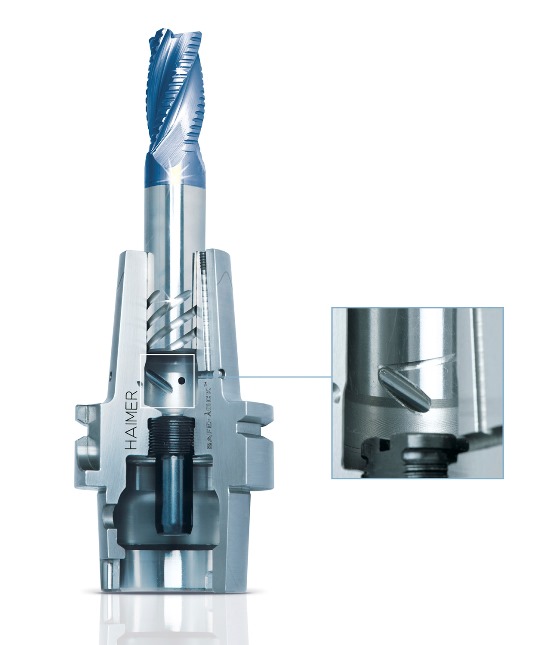
Toolmaker OSG Corp. and toolholding manufacturer Haimer GmbH signed a strategic partnership and licensing agreement in which the OSG-Group's round endmills will include Haimer's Safe-Lock system.
The Safe-Lock design in cutting tools and toolholders combines a press fit clamping with a positive form locking mechanism. This prevents round cutting tools from being rotated or completely pulled out from a toolholder during heavy machining, according to the company. The combination of symmetrical pull-out protection, high concentricity and excellent balance results in a vibration-free machining process, which the company said leads to a more efficient metal-removal rate when compared to conventional milling chucks or Weldon-shank cutting tools and toolholders.
"Our field testing proved that the combination of our endmills with Safe-Lock resulted in higher rpms and feed rates even with difficult-to-machine materials," explained Jiro Osawa, technical managing director at OSG headquarters and CEO for North America. "This enables our customers to obtain a significant increase in their current metal removal rates, while at the same time having a higher security in their machining processes. Safe-Lock also has a positive effect on tool wear."
"We have established Safe-Lock as a standard in roughing and heavy machining for which a variety of tools are available worldwide," said Andreas Haimer, president of the Haimer Group. "We are very proud and happy to have reached a strong partnership with OSG, one of the largest and leading producers of tools in the world."
Related Glossary Terms
- conventional milling ( up milling)
conventional milling ( up milling)
Cutter rotation is opposite that of the feed at the point of contact. Chips are cut at minimal thickness at the initial engagement of the cutter’s teeth with the workpiece and increase to a maximum thickness at the end of engagement. See climb milling.
- feed
feed
Rate of change of position of the tool as a whole, relative to the workpiece while cutting.
- gang cutting ( milling)
gang cutting ( milling)
Machining with several cutters mounted on a single arbor, generally for simultaneous cutting.
- metal-removal rate
metal-removal rate
Rate at which metal is removed from an unfinished part, measured in cubic inches or cubic centimeters per minute.
- milling
milling
Machining operation in which metal or other material is removed by applying power to a rotating cutter. In vertical milling, the cutting tool is mounted vertically on the spindle. In horizontal milling, the cutting tool is mounted horizontally, either directly on the spindle or on an arbor. Horizontal milling is further broken down into conventional milling, where the cutter rotates opposite the direction of feed, or “up” into the workpiece; and climb milling, where the cutter rotates in the direction of feed, or “down” into the workpiece. Milling operations include plane or surface milling, endmilling, facemilling, angle milling, form milling and profiling.
- toolholder
toolholder
Secures a cutting tool during a machining operation. Basic types include block, cartridge, chuck, collet, fixed, modular, quick-change and rotating.








